| Gempylidae (Snake mackerels) |
| 25 cm SL (male/unsexed) |
|
bathypelagic; marine; depth range 914 - 1646 m, oceanodromous |
Atlantic, Indian and Pacific: in tropical and temperate waters.
The southernmost Indian Ocean occurrence (28°08'S, 49°06'E) was based on an unpublished record (R/V VITYAZ-II, station 2781). |
|
Dorsal spines (total): 20-21; Dorsal soft rays (total): 16-19; Anal spines: 1-1; Anal soft rays: 15-19; Vertebrae: 36-38. Body greatly elongated and compressed. Mouth large with fang-like teeth. Tips of both jaws with dermal processes. Color is blackish brown; dorsal and anal fins pale brown; buccal and branchial cavities and peritoneum black. |
| Oceanic, epipelagic to mesopelagic (Ref. 47377), migrating to the surface at night (Ref. 6181). Feeds on myctophids and other small fishes, squid and crustaceans (Ref. 6181). Matures at 15 cm SL (Ref. 36731). |
|
Least Concern (LC); Date assessed: 22 August 2012 Ref. (130435)
|
| harmless |
Source and more info: www.fishbase.org. For personal, classroom, and other internal use only. Not for publication.
